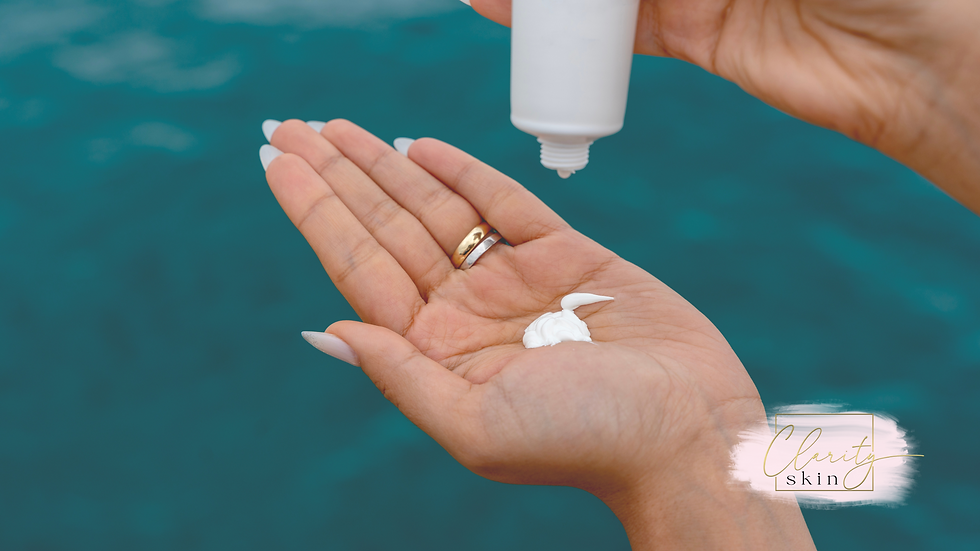Unlocking Radiant Skin with Clarity Skin: Understanding the Difference Between Cleansing and Exfoliating
- Claire Maynard

- Jun 12, 2024
- 3 min read

Introduction
At Clarity Skin, we believe in empowering our clients with the knowledge to make informed decisions about their skin care routine. Two fundamental steps in any regimen are cleansing and exfoliating. While they might seem similar, they serve distinct purposes and are both crucial for maintaining healthy, radiant skin. In this blog, we'll explore the differences between these two essential practices and how they contribute to your overall skin health.
The Importance of a Good Skin Care Routine
A consistent skin care routine is vital for maintaining skin health and achieving a glowing complexion. By understanding the role of each step, you can tailor your regimen to meet your specific skin needs.
Cleansing: The Foundation of Skin Care
What is Cleansing?
Cleansing is the process of removing dirt, oil, makeup, and impurities from the skin’s surface. It is the first step in any skin care routine and prepares the skin for the subsequent steps.
Why is Cleansing Important?
Cleansing helps to:
Prevent clogged pores
Remove excess oil
Wash away bacteria
Create a clean base for other skin care products
Types of Cleansers
Cleansers come in various forms, each suited to different skin types:
Gel Cleansers: Ideal for oily and acne-prone skin
Cream Cleansers: Best for dry and sensitive skin
Foam Cleansers: Suitable for normal to oily skin
Oil Cleansers: Effective for removing makeup and suitable for most skin types. Best when used as the first cleanse in a double-cleansing regimen
How to Properly Cleanse Your Skin
Choose the right cleanser for your skin type.
Use lukewarm water to wet your face.
Apply a small amount of cleanser and massage it into your skin in circular motions.
Rinse thoroughly and pat your face dry with a clean towel.
Exfoliating: Enhancing Skin Texture and Tone
What is Exfoliating?
Exfoliating is the process of removing dead skin cells from the skin’s surface. This can be done mechanically, using physical scrubs, chemically, using acids or enzymes.
Why is Exfoliating Important?
Exfoliating helps to:
Promote cell turnover
Unclog pores
Smooth and refine skin texture
Enhance the absorption of skin care products
Types of Exfoliants
Exfoliants are categorized into two main types:
Physical Exfoliants: Scrubs with granules or brushes that physically slough off dead skin cells.
Chemical Exfoliants: Acids like AHAs (glycolic acid, lactic acid) and BHAs (salicylic acid) that breakdown the "glue" (desomosomes) that hold skin cells together.
Enzymatic Exfoliants: Ingredients like papain (papaya) and bromelein (pineapple) dissolve dead skin cells.
Cleansing vs. Exfoliating: Key Differences
Purpose and Function
Cleansing is for daily removal of dirt, oil, and impurities.
Exfoliating is for removal of dead skin cells to enhance texture and tone.
Frequency of Use
Cleansing should be done twice daily.
Exfoliating should be done anywhere from 1-2 times to twice daily, depending on the type of exfoliant and your skin concerns.
Types of Products
Cleansers: Gel, cream, foam, oil.
Exfoliants: Physical scrubs, chemical acids, enzymes
Impact on Skin
Cleansing maintains daily skin hygiene.
Exfoliating improves skin’s appearance and enhances the effectiveness of other products.
The Role of Clarity Skin in Your Routine
At Clarity Skin, we offer a range of professional treatments and products tailored to your unique skin needs. Our expert team can help you develop a personalized skin care regimen that incorporates the right balance of cleansing and exfoliating to achieve optimal results.
FAQs
What should I look for in a good cleanser? Look for a cleanser that matches your skin type and concerns. Avoid harsh ingredients that can strip your skin of its natural oils.
Can I exfoliate every day? This is dependent on the type of exfoliant you're using as well as your skin concerns. For best results, contact us for a personalized exfoliating regimen.
How do I know if I’m over-exfoliating? Signs of over-exfoliation include redness, sensitivity, and dryness. If you experience these symptoms, reduce the frequency of exfoliation.
Is it necessary to use both a cleanser and an exfoliant? Yes, both are important. Cleansing is for daily maintenance, while exfoliating is for improving texture and removing dead skin cells.
Can I use a physical and chemical exfoliant together? It’s best to use them on different days to avoid over-exfoliation and irritation, but some skin types and conditions do benefit from using them congruently.
What products does Clarity Skin recommend for sensitive skin? For sensitive skin, we recommend gentle, hydrating cleansers and mild chemical exfoliants like mandelic acid. Our team can provide personalized recommendations based on your specific needs.
Conclusion
Understanding the difference between cleansing and exfoliating is crucial for developing an effective skin care routine. At Clarity Skin, we're dedicated to helping you achieve your skin goals with expert advice and tailored treatments. By incorporating the right cleansing and exfoliating practices, you can maintain healthy, radiant skin for years to come. Visit Clarity Skin today to start your journey to glowing skin.







Comments